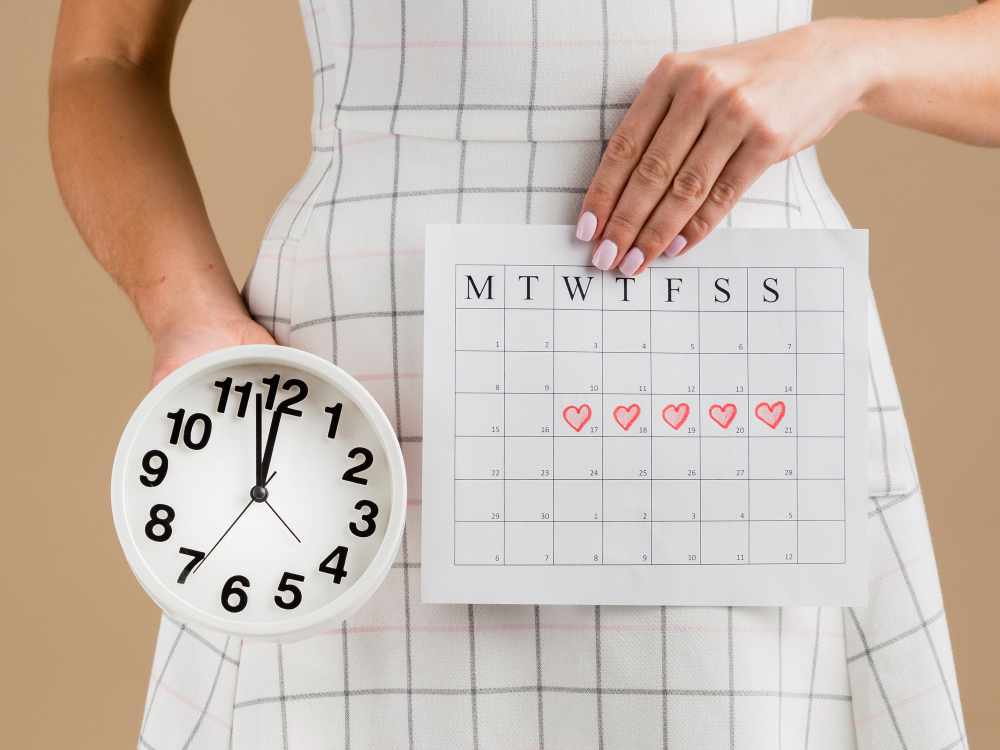Starting a family is a big deal. It is both an exciting and deeply personal decision. Understanding the concept of timing in relation to ovulation can greatly increase the chances of successful conception. Tracking your ovulation cycle will help you understand the most fertile period of your menstrual cycle, making it easier to plan and raising your chances of getting pregnant.

Below we will explore the importance of timing in the context of ovulation. Discover how closely monitoring your ovulation cycle can bring you one step closer to achieving the joy of parenthood.
If you’re hoping to start a family, learning to track your ovulation cycle is a great first step.
What is ovulation?
Ovulation is a stage during your menstrual cycle when the luteinizing hormone (LH) surges, prompting your ovary to release an egg.
What happens during ovulation?
Once the LH hormone surges, your ovary releases the egg that is most ripe. It takes roughly five days for the egg to travel from the ovary to the fallopian tube. At the same time, your cervical mucus becomes more slippery to allow sperm to travel easier. You’ll also start developing your uterine wall.
With the right timing, sperm will fertilize the egg in the fallopian tube as it makes its way to the uterus. The egg’s journey through the fallopian tube only takes 24 hours, so the timing needs to be fairly precise. On the plus side, sperm can survive between three and five days. So, you should be good as long as you’re having lots of sex leading up to that stage.
What happens after ovulation?
If the egg is fertilized, it implants itself in the uterine lining and pregnancy begins. If the egg isn’t fertilized, it doesn’t implant and begins to disintegrate along with the uterine lining. Your period will come two weeks later as your body rids itself of the leftover blood and tissue.
When does ovulation occur ?
The average menstrual cycle lasts 28 to 35 days (though you shouldn’t take this as a given—more on that below).
Typically, ovulation occurs between days 11 to 21 of your cycle. It’s so difficult to accurately pinpoint because nearly 50% of cycles vary by seven or more days. It’s recommended that you track multiple cycles in a row to get a better sense of your average length.
Regardless, ovulation occurs once per cycle, roughly two weeks before your period.
How to track your ovulation cycle:
The first thing you need to do is start tracking your menstrual cycle. Because cycles can vary greatly month-to-month, track multiple periods in a row. Ovulation cycle tracking will help you get a more accurate result.
Day 1 is the first day of your period. Continue counting until the day before your next period starts. This is the last day of your cycle.
Once you’ve tracked multiple cycles in a row, you’ll have a better idea of when you’re most likely to be ovulating. However, it’s not an exact science. With such a small ovulation window, the pressure is on to get the timing right. We recommend taking your basal body temperature and watching for cervical mucus changes in addition to tracking your cycle. Keep reading to learn how to do both.
Ovulation signs and symptoms:
Most women are used to their body sending warning signals during their menstrual cycle telling them their period is coming. The same cannot be said for your ovulation cycle.
Unlike with your menstrual cycle, most women don’t have any ovulation signs or symptoms at all. Some women get mild ovulation cramps, but this is relatively rare. This is bad news if your cycle is difficult to track. The good news is that you can find other signs of ovulation—if you know what to look for.
- Basal body temperature: Basal body temperature is your body’s temperature when fully at rest. In some cases, your basal body temperature can increase by as much as half a degree during ovulation.
You’ll need to purchase an actual basal thermometer, since the measurement is so sensitive. Take your basal temperature the morning of the first day of ovulation, before getting out of bed. Compare this measurement to your basal body temperature when you’re not ovulating. (Make sure to take this measurement a few days ahead of time.) If your temperature is raised by half a degree, then your timing is most likely accurate.
Do bear in mind that several other factors can cause basal body temperature increases, including illness and stress. It’s for this reason that you shouldn’t rely solely on your basal temperature to tell you if you’re ovulating. But taking it in conjunction with other methods can be an effective way to determine ovulation.
- Cervical mucus: Changes to the texture and color of your cervical mucus indicate your level of fertility throughout your cycle. In the days leading up to ovulation, cervical mucus will become thicker and creamier in texture. It’s time to conceive once it becomes clear and slippery. If your cervical mucus doesn’t become clear and slippery, it could mean your chances of conception are less likely that month. Consult your doctor if this is consistent.
When to have sex during ovulation
Now that you know how to track your cycle, you’ll be able to calculate which days you’re most likely to conceive. These are what are known as high and peak fertility days. High fertility starts on the first day of your ovulation cycle, while peak fertility occurs on two days: the day before you ovulate, and the day of ovulation. Your best chances of getting pregnant are during peak fertility. Still, it’s best to have sex every day of your ovulation cycle just to be safe.
Can you get pregnant after ovulation?
There is a slim chance of getting pregnant after ovulation. Ovulation refers to the moment the egg enters the fallopian tube. From that point, you have less than 24 hours to inseminate the egg before it moves on to the uterus. It takes sperm anywhere from 45 minutes to 12 hours to reach the fallopian tube after ejaculation. Fingers crossed they’re speedy swimmers!
When to take an ovulation test ?
Ovulation tests are another over-the-counter option to help you predict when you’re most likely to conceive. These at-home tests are easy to use and offer additional reassurance that you’re timing conception right.
Ovulation tests—also called ovulation kits, ovulation strips, ovulation predictors, and OPKs—measure your LH hormone levels. The goal is to pinpoint when this hormone surges, indicating ovulation.
There are two different types of at-home tests: urine-based ovulation predictor kits and saliva test kits. When to take the test depends on the length of your menstrual cycle. For example, during a 28-day cycle, ovulation typically happens on day 11. You’d therefore want to take an ovulation test on day 10.
There’s no “right” time of day to take either type of test. However, if you’re taking the same ovulation test multiple days in a row, take it at the same time each day. The more consistency, the more accurate the result.
Ovulation test vs. Pregnancy test
There’s often some confusion surrounding the difference between urine-based ovulation predictors and at-home pregnancy tests. Do they test the same hormones? If so, can an ovulation test detect early pregnancy? Will an ovulation test be positive if you’re pregnant? Or, the reverse: Will an ovulation test be negative if you’re pregnant?
First thing’s first: an ovulation test cannot detect pregnancy. The hormones detected by an ovulation test are different from the hormones detected by a pregnancy test. This means that you can have a positive ovulation test and a negative pregnancy test, a double positive, or a double negative. In other words, no, an ovulation test cannot detect early pregnancy, or the absence of one.
So, how can you have a positive ovulation test if you’re already pregnant? Great question. Ovulation tests measure LH hormone levels, which are usually indicators of ovulation. However, ovulation isn’t the only cause of an LH surge. Other factors that can give you a false positive ovulation test result include:
- PCOS
- Genetic disorders
- Luteinized unruptured follicle syndrome (LUFS)
- Pituitary disorders
- Perimenopause or menopause
In case you have any concerns, consult your doctor.
How accurate are ovulation tests?
If you’ve been blessed with a regular menstrual cycle, then taking ovulation tests is actually the most accurate way to measure fertility. If used as directed, most have a 99% accuracy rating. However, bear in mind that these measure the LH levels only, and not when ovulation actually begins. It might take several tries to get it right.
Negative ovulation test: next steps
If your ovulation test comes back negative, don’t stress. You could be testing too early or too late. This is especially common if you have an unpredictable cycle. In some cases, you may need to enlist the help of your doctor in figuring out the problem.
